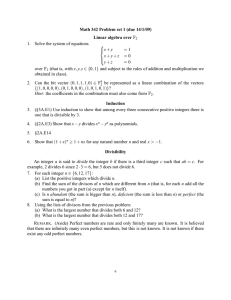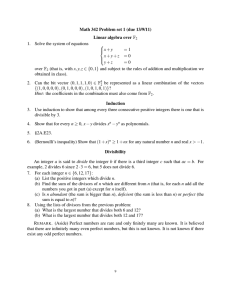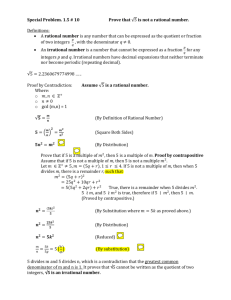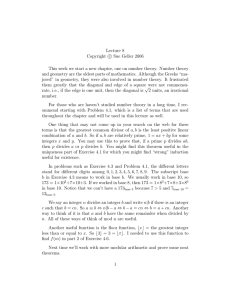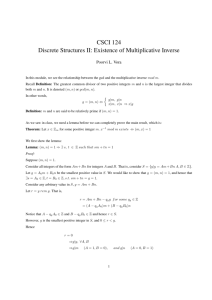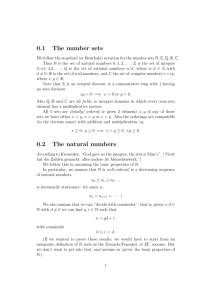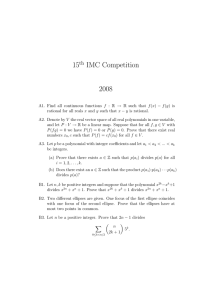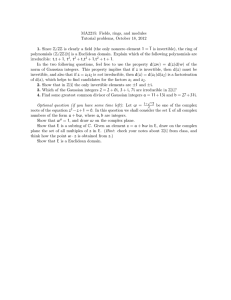Math 220 Exam 2 Partial Solutions November 8, 2013
advertisement
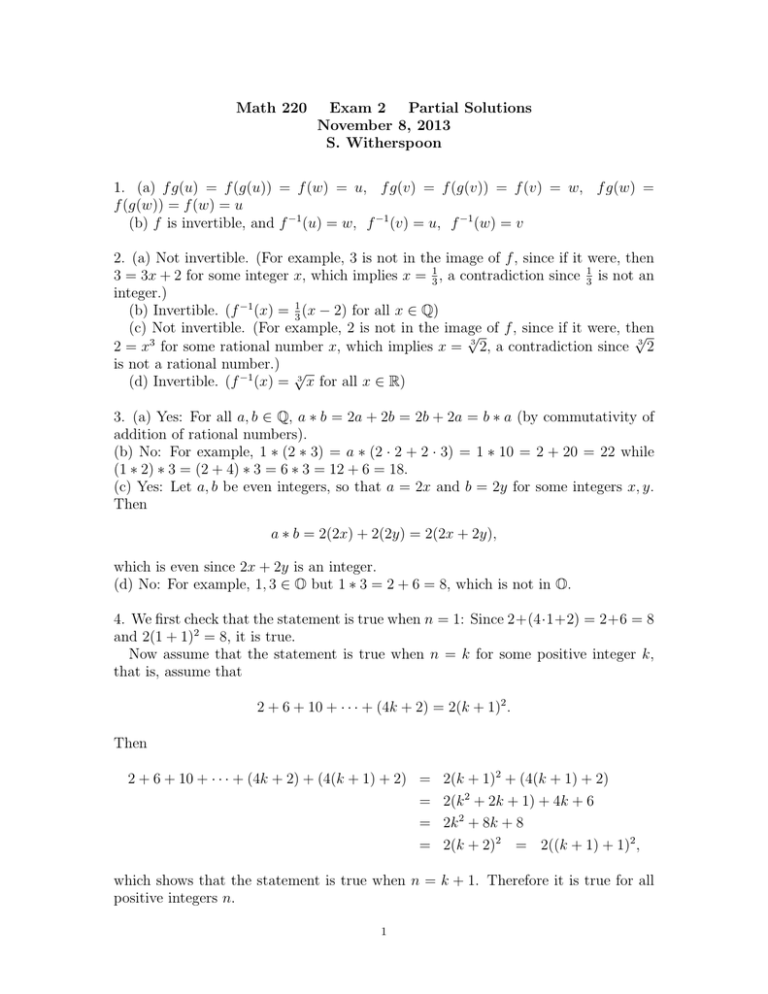
Math 220 Exam 2 Partial Solutions November 8, 2013 S. Witherspoon 1. (a) f g(u) = f (g(u)) = f (w) = u, f g(v) = f (g(v)) = f (v) = w, f g(w) = f (g(w)) = f (w) = u (b) f is invertible, and f −1 (u) = w, f −1 (v) = u, f −1 (w) = v 2. (a) Not invertible. (For example, 3 is not in the image of f , since if it were, then 3 = 3x + 2 for some integer x, which implies x = 31 , a contradiction since 31 is not an integer.) (b) Invertible. (f −1 (x) = 13 (x − 2) for all x ∈ Q) (c) Not invertible. (For example, 2 is not in the image of f , since if it were, then √ √ 3 3 2 = x for some rational number x, which implies x = 2, a contradiction since 3 2 is not a rational number.) √ (d) Invertible. (f −1 (x) = 3 x for all x ∈ R) 3. (a) Yes: For all a, b ∈ Q, a ∗ b = 2a + 2b = 2b + 2a = b ∗ a (by commutativity of addition of rational numbers). (b) No: For example, 1 ∗ (2 ∗ 3) = a ∗ (2 · 2 + 2 · 3) = 1 ∗ 10 = 2 + 20 = 22 while (1 ∗ 2) ∗ 3 = (2 + 4) ∗ 3 = 6 ∗ 3 = 12 + 6 = 18. (c) Yes: Let a, b be even integers, so that a = 2x and b = 2y for some integers x, y. Then a ∗ b = 2(2x) + 2(2y) = 2(2x + 2y), which is even since 2x + 2y is an integer. (d) No: For example, 1, 3 ∈ O but 1 ∗ 3 = 2 + 6 = 8, which is not in O. 4. We first check that the statement is true when n = 1: Since 2+(4·1+2) = 2+6 = 8 and 2(1 + 1)2 = 8, it is true. Now assume that the statement is true when n = k for some positive integer k, that is, assume that 2 + 6 + 10 + · · · + (4k + 2) = 2(k + 1)2 . Then 2 + 6 + 10 + · · · + (4k + 2) + (4(k + 1) + 2) = = = = 2(k + 1)2 + (4(k + 1) + 2) 2(k 2 + 2k + 1) + 4k + 6 2k 2 + 8k + 8 2(k + 2)2 = 2((k + 1) + 1)2 , which shows that the statement is true when n = k + 1. Therefore it is true for all positive integers n. 1 2 5. (a) 48 28 20 8 = = = = 28 · 1 + 20 20 · 1 + 8 8·2+4 4·2 Therefore (48, 28) = 4. (b) Using the results of part (a): 4 = = = = = 20 − 8 · 2 20 − (28 − 20) · 2 20 · 3 − 28 · 2 (48 − 28) · 3 + 28 · (−2) 48 · 3 + 28 · (−5) Therefore we may let x = 3 and y = −5. 6. (a) There are several possible answers. One is a = 4, b = 9. (b) There are several possible answers. One is a = 2, b = 18. (c) Recall from a homework problem (5.4 #9) that a positive integer n is a perfect square if and only if, when n is written in standard form, all of the exponents are even. Setting n = x2 in this problem, then, we may write x2 in standard form: 2nr 2 x2 = p12n1 p2n 2 · · · pr for distinct primes p1 , p2 , . . . , pr and positive integers n1 , n2 , . . . , nr . Since x2 = ab, for each prime factor pi , either pi divides a or pi divides b. Since i divides a. Similarly, if (a, b) = 1, if pi divides a, then it does not divide b, and so p2n i 2ni pi divides b, then pi divides b. Therefore, by relabeling if necessary, a = p12n1 · · · ps2ns 2n r and b = ps+1s+1 · · · p2n r , for some s (1 ≤ s ≤ r). Again, by the homework problem, since in the standard form of a, all exponents are even, a is a perfect square (in fact, a = y 2 where y = pn1 1 · · · pns s ). Similarly, b is a perfect square (b = z 2 where ns+1 z = ps+1 · · · pnr r ).
